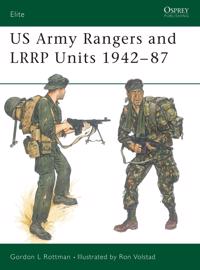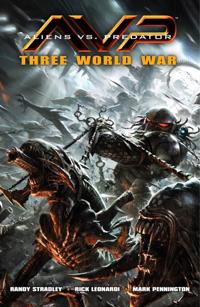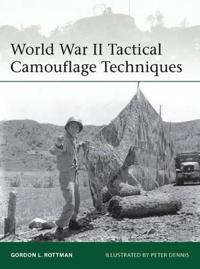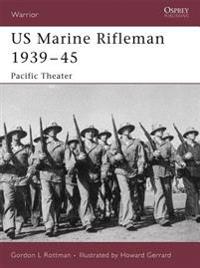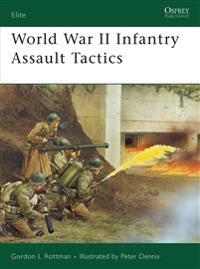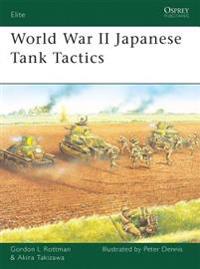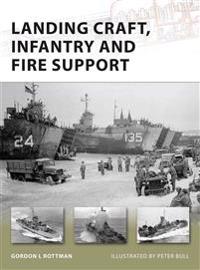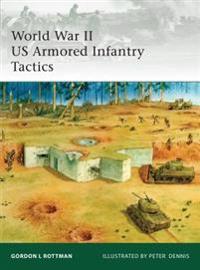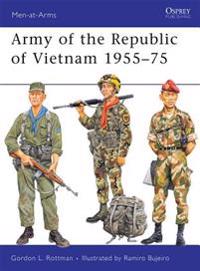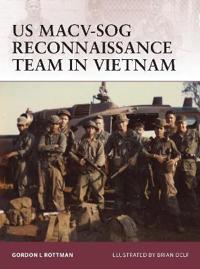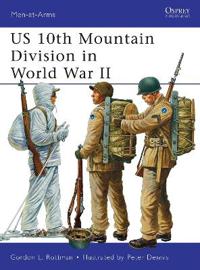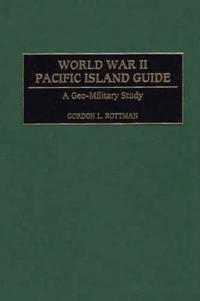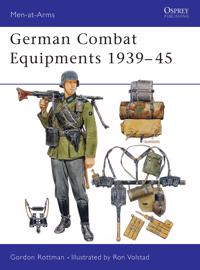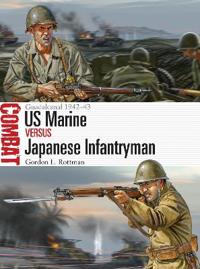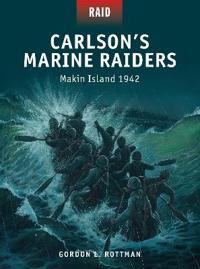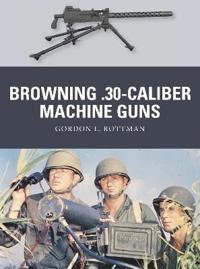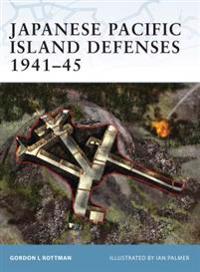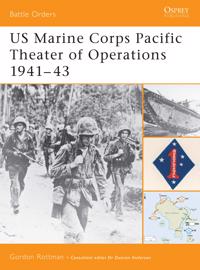US Army Rangers and L.R.R.P.Units, 1942-87 (Häftad)
avGordon L. Rottman
ISBN: 9780850457957 - UTGIVEN: 198709Ranger - the very word conjures up visions of small, highly trained units executing lightning-fast raids on an unexpecting enemy. It is also synonymous with high esprit de corps and excellence at arms. The US Army Rangers provide units of well-disciplined soldiers who possess the knowledge and coura[...]
Aliens Vs. Predator (Häftad)
avGordon L. Rottman, Peter Dennis, Gordon L. Rottman
ISBN: 9781595827029 - UTGIVEN: 201106In "Aliens vs. Predator: Three World War" a long-lost Predator clan stakes its claim for galactic dominance, intent on exterminating its rival clan, the self-same trophy hunters who have plagued Earth's history. And if the advanced technology and military precision of this new threat weren't enough,[...]
World War II Tactical Camouflage Techniques (Pocket)
avGordon L. Rottman, Peter Dennis, Gordon L. Rottman
ISBN: 9781780962740 - UTGIVEN: 201302This book explains and illustrates the actual materials and techniques adopted (both successfully and unsuccessfully) by tactical units - i.e. the concealment of personnel, weapons, equipment, field positions, and movement by infantry riflemen and weapons crews, artillerymen, and vehicle crews. It c[...]
Saipan & Tinian 1944 (Pocket)
avGordon L. Rottman, Howard (ILT) Gerrard, Gordon L. Rottman
ISBN: 9781841768045 - UTGIVEN: 2004-05The 1944 invasion of Saipan was the first two-division amphibious assault conducted by US forces in World War II. Saipan and Tinian had been under Japanese control since 1914 and, heavily colonized, they were considered virtually part of the Empire. The struggle for Saipan and Tinian was characteriz[...]
Inch'on 1950 (Pocket)
avGordon L. Rottman, Peter (ILT) Dennis, Gordon L. Rottman
ISBN: 9781841769615 - UTGIVEN: 2006-04Inch'on was probably the most significant campaign in the Korean theater, as well as being the last major amphibious assault of division-size conducted in the history of warfare. The odds were stacked against the US troops, with virtually no time for training and many of the divisions unprepared for[...]
US Marine Rifleman 1939-45 (Pocket)
avGordon L. Rottman, Howard (ILT) Gerrard, Gordon L. Rottman
ISBN: 9781841769721 - UTGIVEN: 2006-11The Marine Corps began World War II with less than 66,000 officers and men. Yet despite suffering 10 per cent of the overall American casualties, the Marines were able to build on their proud traditions and history to transform a small branch of service into a premier combined arms amphibious assaul[...]
World War II Infantry Assault Tactics (Pocket)
avGordon L. Rottman, Peter Dennis, Gordon L. Rottman
ISBN: 9781846031915 - UTGIVEN: 200803Osprey's examination of assault tactics used by the infantry during World War II (1939-1945). Just about every war movie - famously, "Saving Private Ryan" and "Band of Brothers" - includes dramatic scenes of soldiers trying to attack an enemy pillbox or trench. Continuing the series explaining World[...]
World War II Japanese Tank Tactics (Pocket)
avGordon L. Rottman, Peter (ILT) Dennis, Gordon L. Rottman
ISBN: 9781846032349 - UTGIVEN: 2008-10In this book expert author and tactician Gordon L Rottman provides the first English-language study of Japanese Army and Navy tank units, their tactics and how they were deployed in action. The Japanese army made extensive use of its tanks in the campaigns in China in the 1930s, and it was in these [...]
Landing Craft, Infantry and Fire Support (Pocket)
avGordon L. Rottman, Peter (ILT) Bull, Gordon L. Rottman
ISBN: 9781846034350 - UTGIVEN: 2009-06Described by one soldier as a metal box designed by a sadist to move soldiers across the water, the Landing Craft, Infantry was a large beaching craft intended to deliver an infantry company to a hostile shore, once the beachhead was secured. The LCI and its vehicle-delivery counterpart, the Landing[...]
World War II U. S. Cavalry Units (Pocket)
avGordon L. Rottman, Peter (ILT) Dennis, Gordon L. Rottman
ISBN: 9781846034510 - UTGIVEN: 2009-10At the time of Pearl Harbor, the United States Army still had ten cavalry regiments. The 26th (Filipino Scouts) fought on horseback in the Philippines, while the rest were fought as infantry. Despite this, the cavalry units maintained their own unique traditions, and identity as they saw action in t[...]
World War II U. S. Armored Infantry Tactics (Pocket)
avGordon L. Rottman, Peter (ILT) Dennis, Gordon L. Rottman
ISBN: 9781846036927 - UTGIVEN: 2009-10Little has been published on US armored infantry units and tactics over the years. However, their contribution to the war effort was hugely important. There were a total of 57 armored infantry battalions and two regiments that served throughout the war and in all theaters. Equipped with halftracks, [...]
World War II Battlefield Communications (Pocket)
avGordon L. Rottman, Peter (ILT) Dennis, Gordon L. Rottman
ISBN: 9781846038471 - UTGIVEN: 2010-06Perhaps the biggest difference in the fighting between the two World Wars lay in the invention of the man-portable radio that allowed for a greater degree of tactical coordination than ever before. Gordon L. Rottman provides an informative study of the use of small radios, field telephones, signal f[...]
Army of the Republic of Vietnam 1955-75 (Pocket)
avGordon L. Rottman, Ramiro Bujeiro, Gordon L. Rottman
ISBN: 9781849081818 - UTGIVEN: 201006Evolved from the colonial units created by the French, this book discusses the original reorganization of these forces into the first national army. Complete with a detailed history of the command structure and orders of battle, the author also sheds light on the little known divisional histories of[...]
Vietnam Infantry Tactics (Pocket)
avGordon L. Rottman, Peter Dennis, Gordon L. Rottman
ISBN: 9781849085052 - UTGIVEN: 201106"Vietnam infantry tactics".
US MACV-SOG Reconnaissance Team in Vietnam (Pocket)
avGordon L. Rottman, Brian Delf, Gordon L. Rottman
ISBN: 9781849085137 - UTGIVEN: 201109"US Macv-Sog Reconnaissance Team in Vietnam".
US 10th Mountain Division in World War II (Pocket)
avGordon L. Rottman, Peter Dennis, Gordon L. Rottman
ISBN: 9781849088084 - UTGIVEN: 201210The 10th was the only US mountain division to be raised in World War II, and still has a high profile, being involved in operations from Iraq to Somalia and from Haiti to Afghanistan. It did not arrive in Europe until winter 1944/45, but then fought hard in the harsh mountainous terrain of Northern [...]
World War II Pacific Island Guide (Inbunden)
avGordon L. Rottman
ISBN: 9780313313950 - UTGIVEN: 2001-12Covering all Pacific islands involved in World War II military operations, this book is a detailed, single source of information on virtually every geo-military aspect of the Pacific Theater. Arranged regionally and, to the extent possible, chronologically according to when islands entered the war, [...]
The US Army Special Forces, 1952-84 (Häftad)
avGordon L. Rottman
ISBN: 9780850456103 - UTGIVEN: 198505From its very inception the United States Army Special Forces has been enmeshed in controversy, its mission misunderstood to varying degrees, and its very existence opposed by some of the Army hierarchy. Nevertheless it continues to serve in a highly specialised role in all manner of differing condi[...]
German Combat Equipment, 1939-45 (Häftad)
avGordon L. Rottman
ISBN: 9780850459524 - UTGIVEN: 199104The field equipment of the German Army in World War II was closely related to that used throughout World War I and earlier, yet it was of relatively light weight, ruggedly constructed, well designed, functional, and generally of a high quality, though this deteriorated in the later war years. A high[...]
US Marine vs Japanese Infantryman - Guadalcanal 1942-43 (Häftad)
avGordon L. Rottman
ISBN: 9781472801340 - UTGIVEN: 2014-09The brutal fighting between US Marines and Japanese infantry on the island of Guadalcanal in many ways came to typify the island-hopping war in the Pacific. This book not only explores the differing tactics and equipment used by the two combatants but also shows how the challenges of fighting in inh[...]
Carlson's Marine Raiders (Pocket)
avGordon L. Rottman
ISBN: 9781472803276 - UTGIVEN: 2014-06On August 17-18, 1942, 211 men of the US Marine Corps' 2nd Raider Battalion conducted a daring amphibious raid on the Japanese-occupied Makin Island in the South Pacific. This ambitious but flawed operation was intended to divert Japanese reinforcements bound for Guadalcanal, over 1,000 miles to the[...]
Browning .30-caliber Machine Guns (Häftad)
avGordon L. Rottman
ISBN: 9781780969213 - UTGIVEN: 2014-02First adopted in 1917, the rugged and reliable Browning .30-caliber machine gun remained in US service into the Vietnam era, and is still occasionally found in use elsewhere even today. Produced in both water-cooled and air-cooled versions, it has been employed in every imaginable role for a machine[...]
Panzerfaust and Panzerschreck (Häftad)
avGordon L. Rottman
ISBN: 9781782007883 - UTGIVEN: 2014-08Two of World War II's most distinctive weapons, the Panzerfaust and Panzerschreck offered German and other infantrymen the ability to destroy enemy tanks singlehandedly at close ranges. While the Panzerschreck owed its origins largely to the US bazooka, the Panzerfaust was a revolutionary design tha[...]
Japanese Pacific Island Defenses 1941-45 (Häftad)
avGordon L. Rottman
ISBN: 9781841764283 - UTGIVEN: 200302This is the first title in a series that takes a detailed look at fortifications and defensive systems throughout history. The prolonged and bloody fighting for control of the Japanese occupied Pacific islands in World War II is a key point in the history of 20th century warfare. No two islands were[...]
Us Marine Corps Pacific Theater of Operations (1) (Häftad)
avGordon L. Rottman
ISBN: 9781841765181 - UTGIVEN: 200402The early days of the Pacific War found the United States facing an enemy who had occupied a series of islands in the South Pacific. The enemy's goal in this region was to provide an outer defensive zone to protect bases from which future conquests would be launched. The enemy was Japan. This highly[...]

